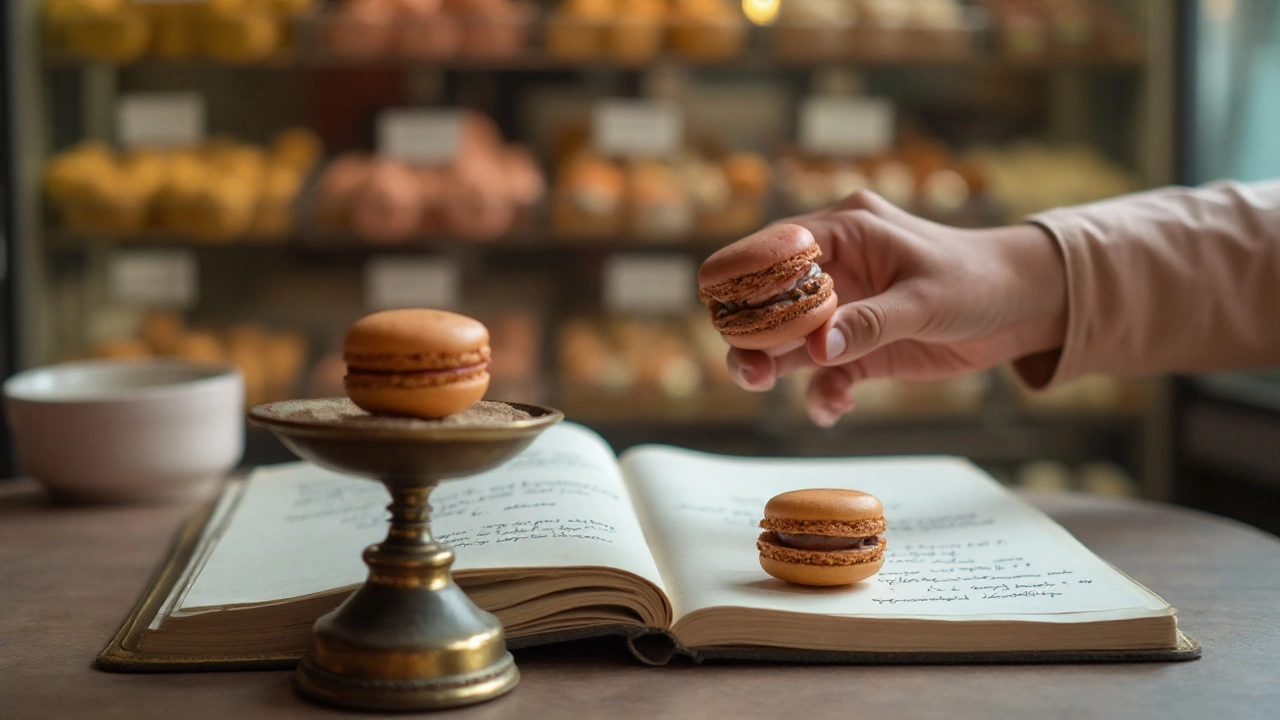Bet you didn’t expect a single macaron to be such a heavyweight in the world of desserts—at least when it comes to all the tiny details that go into making one. The truth is, if you’re trying to perfect your macarons, sell them, or just satisfy your curiosity, knowing how many grams are in one macaron is a lot more useful than you’d think. If you’ve ever glanced at a recipe and wondered if your treats are standard-sized, weighed a box before gifting it to a friend, or simply tried to calculate just how much sugar you’ve actually snacked on, you're definitely not alone. One macaron isn't just a pretty bite; it's a carefully balanced result of technique, tradition, and, yes, lots of measuring.
What Does a Standard Macaron Weigh?
The secret is out—there’s an actual number that bakers and patisseries shoot for, and it’s somewhere between 10 and 14 grams per macaron. For most French-style macarons—the little pastel sandwich cookies that have been flooding Instagram for years—the sweet spot is right at 12 grams. That number? It comes straight from traditional French pastry guides. All this measuring isn’t for show. If a macaron is too light, it ends up hollow or brittle. If it’s too heavy, you lose that classic balance: crisp shell, chewy interior, and the gentle press of filling every time you bite down. For bakers like me, getting it wrong even by a couple grams is one way to end up with a tray that even Muffin (our cat, with very low standards) turns her nose up at.
Now, before you grab your kitchen scale, let’s get specific. The 12-gram standard isn’t random—it reflects the portion that fits nicely between your fingers, won’t shatter from a gentle press, and holds just enough filling to wow your taste buds. Just for kicks, here’s how the numbers typically break down in actual pastry shop practice:
| Type | Macaron Only (shells) | Macaron with Filling |
|---|---|---|
| Standard (diameter ~3.5cm) | 7g | 12g |
| Mini Macaron (~2.5cm) | 3g | 6g |
| Large Macaron (~5cm+) | 12g | 20g |
These aren’t just numbers on a napkin; big patisserie brands like Ladurée and Pierre Hermé actually sell theirs at the 12g mark, and you’ll see this number repeated in catering guides, food trade regulations, and home baking standards. Curious why the precision? Consistency means that when you order a dozen, you’re not getting short-changed or accidentally overloading on calories.
But don’t get stuck in the idea that there’s only one right answer. The grams can shift depending on the shell recipe, the filling, and even the humidity in your kitchen. For example, macarons with a thick ganache or lots of jam will cause the scale to tip higher than those with a light buttercream. In the competitive world of food contests and bakery displays, the standard is strict—but for home bakers, there’s room to play.

What Changes the Weight of a Macaron?
If you ever bring a batch of macarons to a party and someone asks how many grams in a macaron, you can show off with more than just the round number. There’s a reason the answer can flex a little—it all comes down to the details. Everything from the temperature outside to the way you whip your egg whites adds grams somewhere. Think I’m exaggerating? Try this:
- Size: The bigger you pipe, the heavier it gets. Traditional ones are about 3.5cm wide, but some creative shops go mini (as tiny as 2.5cm) or supersized (5cm or more).
- Sugar Content: If your shells are loaded with powdered sugar, they’ll come out denser. Substitute with almond flour that’s very fine, and the overall weight drops a touch.
- Filling: Ganache, jam, buttercream—each filling brings a different density. Chocolate ganache is heavier than citrus buttercream, for example.
- Moisture: Rainy day? Humid? The shells can absorb water from the air, getting a couple grams heavier overnight.
- Shell Thickness: Over-mixing your batter or baking a little too long will shrink your shells. Thin shells shave off precious grams, but make the cookie less sturdy.
- Resting Time: Leave macarons longer before filling and they dry out, making them slightly lighter.
I once made a batch that screamed "Instagram goals," but Harrison (always the critic) pointed out they felt heavy. A quick trip to the kitchen scale showed these beauties tipped out at 16 grams each thanks to my overly generous chocolate hazelnut filling. Lesson learned.
Some people even adjust weight to match the filling to the shell, going a little heavier for nut-based creams or lighter for whipped ganache. It’s not just about calories, either. Macarons are notorious for being picky with texture—get the weight right, and you’ll preserve that crisp bite meeting chewy center. Mess it up, and you’re stuck with crunchy, stale-tasting shells or soggy bottoms that stick to the paper like sad little pancakes.
Baking for a crowd or selling your treats? Consider this: packaging is often sold in fixed sizes. Knowing each macaron weighs about 12g helps you estimate how many will fit a box, how much the box weighs when full, and how much to charge. No more guessing if you’re short-changing your customers.
If you’re counting calories or want to know exactly what you’re eating (or gifting), tally it up. The average 12g macaron holds about 45-60 calories, with most of the weight split evenly between shell and filling. Add in certain flavorings (like salted caramel or matcha), and the numbers change a bit, but you’ll rarely see classic macarons go higher than 15 grams unless someone’s gotten really generous with the filling.

Why Knowing Gram Weight Matters in Baking and Beyond
If there’s one thing I love about macarons (besides seeing Muffin watching the beater in action), it’s how baking them teaches you precision. Getting the weight right is a small detail, but it opens up a world of possibilities. For one, you can finally compare apples to apples with online recipes. Ever see a post that says "makes 20 macarons"—only to pull out 30 tiny ones or 9 massive cookies? Knowing the standard weight saves you from recipe roulette. You’ll know how many can be expected from a batch, how much almond flour or sugar to buy, and how to portion the filling without running out halfway through.
And then there’s selling. Whether it’s a booth at the farmer’s market or a wedding order, consistency wins people over. Patisseries keep to the 12g weight because customers adore reliability. If they fall in love with your pistachio macaron, they expect the same taste and size every time. Plus, some countries even have food regulations demanding advertised weights for packaged goods, making a kitchen scale just as important as your best piping bag.
On the flip side, maybe you’re watching your sugar intake (the holidays sneak up fast). Macarons aren’t calorie-free, but the 12-gram figure means you know almost exactly what you’re getting. Want to cut back? Make minis at 6 grams each and enjoy more variety—one for every craving and color.
There’s a science to tweaking the recipe, too. Professional bakers often test new flavors or fillings by measuring the finished macaron in grams, adjusting ratios until they hit the magic 12g mark and maintain the snap-chew balance. If you’re the type who loves spreadsheets as much as spatulas, try tracking every batch for a month; you’ll be surprised how much the room temperature, your oven, and even the brand of almond flour affect your average.
For home bakers, here are some tips to get consistent macaron grams every time:
- Use a digital kitchen scale for each shell before and after filling.
- Pipe uniform circles using a printable template under your parchment paper.
- Be mindful of filling thickness—use a piping bag for even distribution.
- Let the shells rest long enough, so they don’t soak up excess air moisture before baking.
- Store in airtight containers and check their weight over a few days to see if the filling causes changes.
There’s something a little magic about a dessert that’s all about the tiny details. Macarons prove you don’t have to be big to make an impact, and whether you’re baking a single box for date night or fifty for a birthday bash, tracking the weight will help you nail it every time. Bonus: now when someone asks at brunch, "How many grams in one macaron?"—you’ll have more than enough to say while passing the pastry plate around the table. And trust me, once you taste a macaron that lands precisely at 12 grams, you’ll never go back to guessing or eyeballing again.